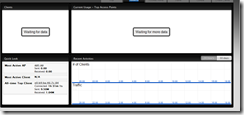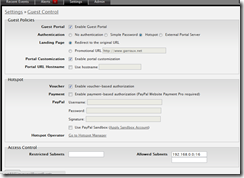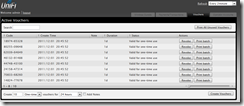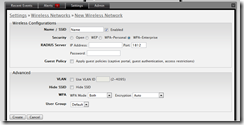First Thoughts on Ubiquiti Unifi
I purchased a Ubiquiti Unifi AP earlier this week and have been pretty impressed. The Unifi AP’s are super super cheap ($70 - 80), and the controller software is free. The UAP Mini’s, which have a shorter range / slower speed cost about $60, though it’s hard to find anywhere online that has them available. ( Amusingly, I can only just barely buy a Cisco PoE injector for this amount ) These are enterprise class AP’s - they support 802.1q, multiple SSID’s, WPA enterprise, centralized management, etc. All of the current models are 2.4 ghz only, supposedly dual-band models will be released in the future.
They also support a captive portal, which is super easy to configure with either a static password, generated one-time-use vouchers, etc. This is the only part that actually depends on the controller service. So, if the controller is down (or inaccessible), everything will continue to work normally except guest access. This is pretty nice, as it let’s you have a single controller for multiple sites, without having to worry too much about what happens if the sites are disconnected. I have screenshots of the guest policy and voucher interfaces below.
I do have a few small gripes / annoyances. Hopefully some of these will be addressed as the controller software becomes more mature. It looks like a long list - but I don’t think any of these would be deal-breakers in most small or medium sized environments.
-
Limited to 4 SSID’s / VLAN’s on each AP. This probably isn’t an issue in most environments, but it could be in some. As it is though, these AP’s are probably cheap enough that you could deploy additional AP’s to handle the additional VLAN’s and still end up spending way less than you would with Cisco, et al.
-
Configuration changes take AP’s offline for short period When I make a change on one of the SSID’s / VLAN’s, the AP goes into a provisioning mode for a minute or so. When this is occurring my wireless clients are disconnected. Not sure how this is handled in a multi-AP environment. My hope is that the provisioning would be staggered, so clients would be able to connect to another AP while the AP they were originally associated with is rep-provisioned. If not, any configuration changes become events requiring downtime, which would be disappointing.
-
No SNMP Support SNMP is currently not supported in the controller software, or on the devices themselves. This isn’t a huge deal for me (It’s easier to monitor the bandwidth usage via the switchports), but I can imagine it would be super-nice to have in many environments. The controller software has some monitoring built in to it - the controller can send email alerts if a AP goes offline and can show usage graphs (see screenshot below).

-
On Windows, controller software doesn’t use a service by default When installed on Windows, the controller software doesn’t use a Windows service out of the box. There is an option in the software to install a service ( see this post on the Ubiquiti forum ). I’m not sure why this isn’t done by default though. I can’t imagine any instance where you would not want software like this to be a service.
-
Only a single RADIUS Server can be Configured Only one RADIUS server configured, no failover. Cisco’s Aironet devices support configuring multiple redundant RADIUS servers. It would be nice to see this feature added. You could potentially use some kind of clustering or load balancing to still have redundancy though if you wanted. See screenshot of the SSID configuration interface below:
There are some other things that would be nice to have, like:
-
Multiple guest policy profiles Right now, you have one guest policy that is applied to all SSID’s that have the captive portal features enabled. It could be nice to have multiple guest profiles.though I admit I can’t come up with a common use-case.
-
Standardized PoE Ubiquiti uses a modified version of PoE. They do ship a PoE injector with their devices, but it would be annoying to have to use these if I had a large number of AP’s and already had a PoE capable switch. I’ve heard a UAP Pro mentioned on the Ubiquiti forums that sounds like it’ll use 802.3af.
-
Gigabit All of the Unifi AP’s currently offered (UAP, UAP Mini, UAP Long Range, and an external model) have a single 100 Mbps port. The 150 - 300 Mbps they claim to support support with 802.11n pretty useless with a 100 Mbps uplink.
I’ve heard of a UAP “Pro” mentioned on the Ubiquiti forums that will add a couple of these features (802.3af PoE, and gigabit interfaces).
Overall I love Unifi. If your environment can live with these annoyances, frankly I don’t see any reason why you would use anything other than Unifi.
The company I work for uses Ubiquiti AirOS devices for a short point to point connection. I also have set up Ubiquiti AirOS devices at the UNC Project in Malawi for point-to-point links there between satellite clinics. In both of these cases they perform fantastically.
I’m excited to see where Ubiquiti will go in the future - they have some really great products. Find more details on Unifi at Ubiquiti’s website.



